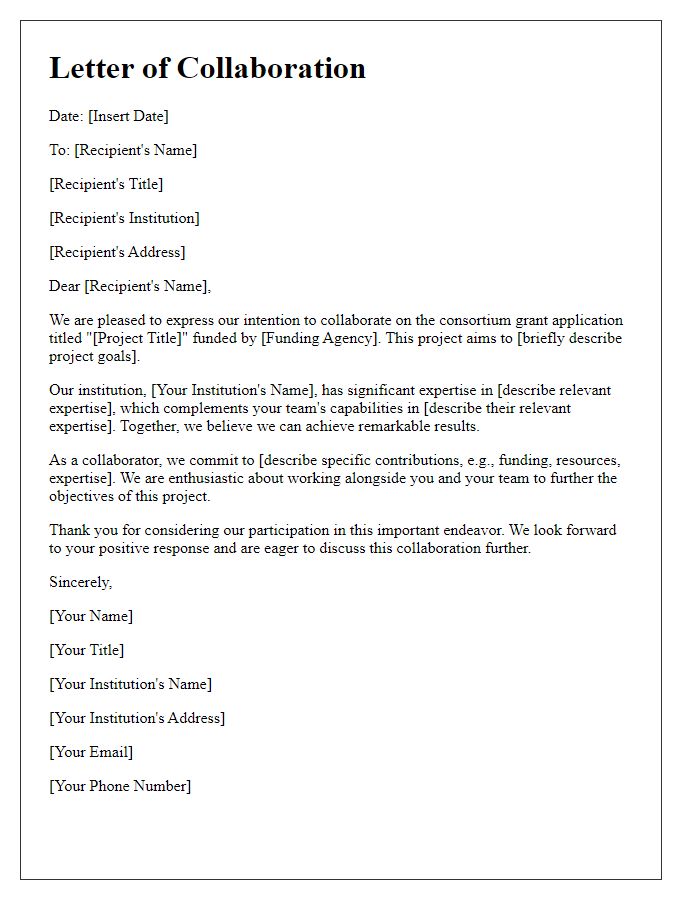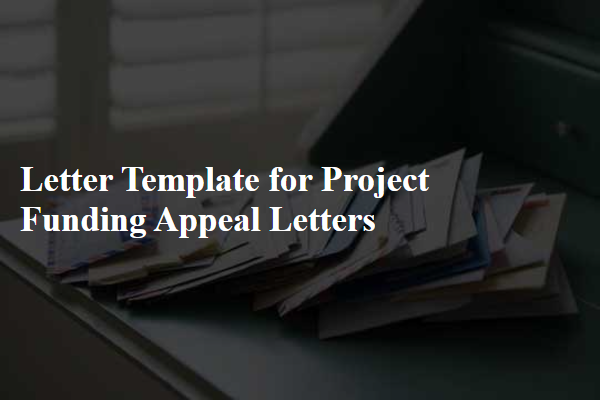Are you looking to team up for a successful grant application? Collaborating with like-minded individuals or organizations can significantly enhance your chances of securing funding while bringing diverse perspectives to your project. Whether you're a seasoned grant writer or just starting out, crafting a compelling letter is crucial to showcase your partnership and shared goals. Join us as we explore the essential elements of a collaborative grant application letter, and discover how to make your proposal stand out!

Purpose and Goals
Collaborative grant applications aim to foster partnerships between multiple organizations to address significant challenges and create impactful solutions. These partnerships can boost resource sharing, leverage diverse expertise, and enhance community engagement. The primary purpose of such grants is to fund projects that align with shared goals, such as improving education in under-resourced areas, facilitating medical research on diseases affecting vulnerable populations, or advancing technology for sustainable energy practices. Successful grant applications clearly define measurable objectives, such as increasing literacy rates by 20% within two years, conducting three clinical trials within a specified timeframe, or reducing carbon emissions by 30% through innovative renewable energy solutions. These articulated goals not only provide a roadmap for the project's success but also demonstrate the collaborative commitment to achieving significant and lasting social impact.
Team Composition and Roles
In a collaborative grant application for a research project, the team's composition and roles are crucial elements determining the project's success. The research team consists of distinguished professionals, each bringing unique expertise, such as Dr. Jane Smith, a molecular biologist specializing in gene editing at Stanford University, and Dr. John Doe, a computational scientist known for his work in data modeling at MIT. Their collaborative efforts will include Dr. Emily Wang, a clinical researcher affiliated with Johns Hopkins University, who will lead patient recruitment and data collection. Support from the administrative coordinator, Ms. Laura Chen, will ensure seamless communication and compliance with grant regulations. The team will also rely on input from Dr. Michael Brown, a statistician with experience in clinical trial analysis, to interpret complex data sets effectively. Together, this interdisciplinary team aims to innovate and advance understanding of rare genetic disorders through dedicated research efforts.
Research Methodology
The research methodology section outlines the systematic approach for investigating the study's hypotheses within the collaborative grant application. The mixed-method design integrates qualitative and quantitative research techniques to gather comprehensive data. Data collection methods will include structured surveys targeting a sample size of 500 participants across diverse demographics, ensuring representativeness from both urban and rural areas. Qualitative interviews with 30 key stakeholders aim to derive in-depth insights into community perspectives. Statistical analysis will involve software tools such as SPSS for quantitative data, while thematic analysis will be employed for qualitative findings. Ethical considerations prioritize participant confidentiality and informed consent, aligning with the guidelines set forth by institutional review boards. Collaborative efforts across institutions will enhance resource sharing, broaden expertise, and facilitate knowledge dissemination in journal publications and conference presentations.
Impact and Innovation
Collaborative grant applications often emphasize the significance of impact and innovation in the project's scope. Innovative strategies could involve novel approaches to research methodologies or technology integration. For instance, using Artificial Intelligence (AI) for data analysis can enhance productivity and accuracy in studies related to climate change adaptation. The impact of the proposed work might involve measurable outcomes, such as reducing greenhouse gas emissions by 20% over five years through the implementation of sustainable practices. Partnerships with local governments, such as the City of Seattle (known for its environmental initiatives), can deepen the project's reach and effectiveness. Additionally, incorporating stakeholder feedback during the project design can elevate community engagement, ensuring that solutions are not only innovative but also relevant and practical. Engaging educational institutions, such as the University of Washington, can foster interdisciplinary collaboration, merging technology with social sciences for comprehensive solutions.
Funding Requirements and Budget
The collaborative grant application requires a comprehensive budget outline detailing the funding requirements for each participating entity, including research institutions such as universities and non-profits. The budget must specify direct costs, including personnel salaries (positions like principal investigators and research assistants), equipment expenses (funds for laboratory instruments valued at over $10,000), and materials (consumables such as reagents and supplies). Indirect costs should also be calculated according to institutional guidelines, often capped at a certain percentage of the direct costs, typically around 30% for federal grants. Additionally, the application must highlight anticipated expenditures for travel (including conferences and collaborative meetings), estimated at $5,000, and any potential subawards to partner organizations, which may exceed $15,000. A contingency fund, approximately 5% of the total budget, should cover unforeseen expenses. All financial documentation must adhere to the grant agency's compliance regulations, ensuring transparency and accountability throughout the funding lifecycle.













Comments